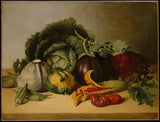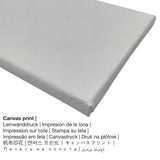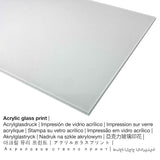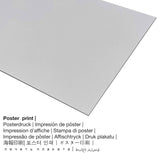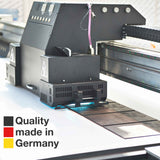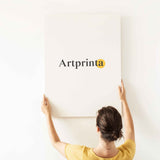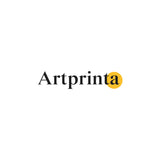James Peale, 1820 - Ka Ndụ: Balsam Apple na Akwụkwọ nri - ọmarịcha nka
Ụtụ gụnyere. Mbupu gbakọrọ na ndenye ọpụpụ.
Ozi izizi gbasara nka sitere na webụsaịtị ihe ngosi nka (© Nwebiisinka - The Metropolitan Museum of Art - www.metmuseum.org)
This painting dates from a peak period of James Peale's career. While he typically used somber colors and linear forms, his use of vivid colors and painterly execution in this work suggest that it is a somewhat experimental exercise. With its focus on lavish vegetable forms, this work resembles still lifes of the Spanish school. The vegetables are, from left to right, okra, blue-green cabbage, crinkly Savoy cabbage, Hubbard squash, eggplant, balsam apple, tomatoes, and purple-red cabbage.
Ozi ndabere na ọrụ nka
| Aha ọrụ nka: | "Still Life: Balsam Apple and Vegetables" |
| Nhazi nke ihe nka: | sere |
| Category: | nkà nke oge a |
| Time: | 19th narị afọ |
| Emepụtara na: | 1820 |
| Afọ nka: | karịa afọ 200 |
| Agba na: | mmanụ na kwaaji |
| Akụkụ izizi: | 20 1/4 x 26 1/2 na (51,4 x 67,3 cm) |
| Ụlọ ihe ngosi nka / ebe: | Museumlọ ihe ngosi nka nke Obodo |
| Ebe ngosi nka: | New York City, New York, Njikota Obodo Amerika |
| Dị n'okpuru: | Museumlọ ihe ngosi nka nke Obodo |
| License: | ngalaba ọha |
| Site n'aka: | Ụlọ ihe ngosi nka nke Metropolitan, New York, Maria DeWitt Jesup Fund, 1939 |
| Ebe E Si Nweta: | Maria DeWitt Jesup Fund, 1939 |
Tebụl nchịkọta ihe nkiri
| aha: | James Peale |
| Aha ndị ọzọ: | Peale James, James Peale |
| okike onye nka: | nwoke |
| Obodo onye nka: | American |
| Ọrụ onye na-ese ihe: | Onye omenkà America |
| Country: | United States |
| nhazi ọkwa: | omenkà nke oge a |
| Ụdị nka: | Ihunanya |
| Oge ndu: | 82 afọ |
| A mụrụ: | 1749 |
| Ebe omuma: | Obodo Chestertown |
| Nwụrụ n'afọ: | 1831 |
Nkọwa akụkọ ahaziri ahazi
| Nkewa edemede: | ezi nka mmeputakwa |
| Mmeputakwa: | mmeputakwa n'ụdị dijitalụ |
| Usoro nhazi: | Mbipụta UV / dijitalụ |
| Production: | Germany |
| Stockdị ngwaahịa: | a na-achọ |
| Ngwaahịa were: | ime ụlọ, nka mgbidi |
| Ndepụta: | nhazi odida obodo |
| Ụdị anya: | 4: 3 (ogologo: obosara) |
| Nsonaazụ: | ogologo bụ 33% ogologo karịa obosara |
| Akụrụngwa ị nwere ike ịhọrọ: | Mbipụta kwaaji, mbipụta ọla (aluminium dibond), mbipụta akwụkwọ mmado (akwụkwọ kwaaji), mbipụta enyo acrylic (nwere ezigbo mkpuchi iko) |
| Mpempe akwa akwa (akwa akwa na etiti ihe ndọtị) nha: | 40x30cm - 16x12", 80x60cm - 31x24", 120x90cm - 47x35", 160x120cm - 63x47" |
| Mbipụta iko acrylic (nke nwere ezigbo mkpuchi iko): | 40x30cm - 16x12", 80x60cm - 31x24", 120x90cm - 47x35", 160x120cm - 63x47" |
| Nhọrọ nha nke akwụkwọ mmado (akwụkwọ kwaaji): | 40x30cm - 16x12", 80x60cm - 31x24", 120x90cm - 47x35" |
| Mbipụta nke aluminom: | 40x30cm - 16x12", 80x60cm - 31x24", 120x90cm - 47x35" |
| Nhazi mbipụta nka: | agunyeghi |
Họrọ ụdị ihe onwunwe gị
Anyị na-enye ụdị nha na ihe dị iche iche maka ngwaahịa ọ bụla. Nha na ihe ndị a bụ nhọrọ anyị na-enye gị maka nkeonwe:
- Mbipụta akwụkwọ mmado (akwa akwa akwa): The Artprinta poster is a UV printed sheet of canvas with a granular structure on the surface. Please bear in mind, that depending on the absolute size of the poster we add a white margin of approximately 2-6cm around the print motif in order to facilitate the framing.
- Mbipụta kwaaji: The canvas print, not to be mistaken with an artwork painted on a canvas, is a digital copy printed directly on cotton canvas material. In addition to that, a canvas creates a cosy and positive look. Canvas prints are relatively low in weight, meaning that it is easy and straightforward to hang up the Canvas print without extra wall-mounts. A canvas print is suited for any type of wall.
- Mbipụta aluminom (aluminium dibbond): This is a metal print manufactured on aluminium dibond with a true depth. A non-reflective surface structure creates a modern look. The bright & white sections of the artpiece shine with a silky gloss, however without glow. The colors of the print are luminous in the highest definition, the details of the print appear crisp.
- Mbipụta iko acrylic (nke nwere ezigbo mkpuchi iko): An print on acrylic glass, often named a UV print on plexiglass, will transform the artwork into magnificient wall décor. The major upside of a plexiglass fine art print is that sharp contrasts and smaller color details become more identifiable because of the granular gradation in the print. The plexiglass with real glass coating protects your custom art print against sunlight and heat for many decades.
Kedu ụdị ngwaahịa anyị na-enye ebe a?
This over 200 year-old artpiece was created by the painter James Peale in 1820. Ihe gafere 200 ụdị mbụ nke afọ na-atụ nha - 20 1/4 x 26 1/2 na (51,4 x 67,3 cm). Mmanụ na kwaaji was used by the American artist as the medium of the artwork. Moveover, this work of art is in the the Ụlọ ihe ngosi nka nke Metropolitan collection located in New York City, New York, United States of America. With courtesy of: The Metropolitan Museum of Art, New York, Maria DeWitt Jesup Fund, 1939 (ikike ngalaba ọha). Ọzọkwa, ọrụ nka nwere akara kredit ndị a: Maria DeWitt Jesup Fund, 1939. Ọzọkwa, alignment bụ odida obodo na nwere akụkụ ruru nke 4: 3, nke pụtara na ogologo bụ 33% ogologo karịa obosara. James Peale was a American artist of American nationality, whose style can mainly be classified as Romanticism. The painter lived for a total of 82 afọ a mụrụ ya n'afọ 1749 in Chestertown and passed away in the year 1831.
Ederede iwu dị mkpa: We try what we can in order to depict the art products as precisely as possible and to exhibit them visually in our shop. Although, the colors of the print products and the printing can vary somehwat from the presentation on the device's screen. Depending on the screen settings and the nature of the surface, not all colors are printed as realisitcally as the digital version shown here. Given that all the fine art prints are processed and printed by hand, there might also be minor differences in the motif's exact position and the size.
Nwebiisinka © - Artprinta.com

